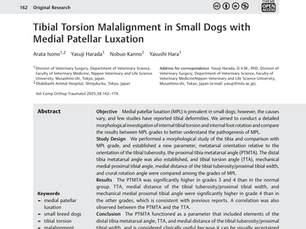top of page
Literature Review


Comments on the Effect of an Orthogonal Locking Plate and Primary Plate Working Length on Construct Stiffness and Plate Strain in an In Vitro Fracture-Gap Model
My Comments on the Article You can find my letter to the editor here . The authors' reply can be found here . This study demonstrates significant effort by the researchers, whose primary concern was whether the working length of an implant affects its stress/strain. For this, they used constructs with different working lengths and measured the strain at the middle part of the plate. They stated that they chose four-point bending to ensure a constant bending moment along the l

Christos Nikolaou
Nov 136 min read



Christos Nikolaou
Jul 240 min read



Christos Nikolaou
Jul 230 min read



Christos Nikolaou
Jul 220 min read



Christos Nikolaou
Jul 220 min read



Christos Nikolaou
Jul 210 min read


TPLO to a TPA of 5 degrees - Reif et al.
This is the second post in a series investigating the reasons why the number 5 is so well-embedded in the TPLO literature. Effect of Tibial Plateau Leveling on Stability of the Canine Cranial Cruciate-Deficient Stifle Joint: In Vitro Study Ullrich Reif, Donald A Hulse, Joe G Hauptman The primary objective of the study was to assess the caudal tibial thrust generated after a TPLO procedure, specifically in relation to a tibial plateau angle (TPA) of 5 degrees. The researchers

Christos Nikolaou
Mar 313 min read


The unbeatable 5 - Warzee et. al.
Effect of Tibial Plateau Leveling on Cranial and Caudal Tibial Thrusts in Canine Cranial Cruciate-Deficient Stifles: An In Vitro Experimental Study. Christine C, Warzee, Loic M. Dejardin, Steven P. Arnoczky, Ruby L. Perry Veterinary Surgery 30:278-286, 2001 The researchers used fifteen pelvic limbs from adult dogs of similar size and body weight (range, 27 to 36 kg), which were euthanised for reasons unrelated to the study. The limbs were mounted on a device with the stifles

Christos Nikolaou
Mar 276 min read


The 5-degree golden rule - An Introduction
The target tibial plateau (TPA) angle of 5 degrees for the TPLO procedure is so inherent to our everyday practice that it has become an unquestionable rule for almost two decades. Although I do not question that this target angle will serve most patients well, I wanted to understand the origin of the 5-degree golden rule and challenge its robustness. The TPLO technique was first published by its inventors in 1993 (1). In this first publication, the authors suggest that levell

Christos Nikolaou
Mar 272 min read


Comments on the Effect of an Orthogonal Locking Plate and Primary Plate Working Length on Construct Stiffness and Plate Strain in an In vitro Fracture-Gap Model.
This is not an easy read and not the simplified biomechanics in simple English I promised to deliver in my Introduction article. Nevertheless, you may find it interesting as it results from analytical thinking, where each mathematically solid statement follows the next in a logical order. This article has been published here . You can view the reply to this article here . Although I disagree with the authors' reply, this does not mean their results are invalid. Nevertheless,

Christos Nikolaou
Jan 121 min read
bottom of page
_edited.png)